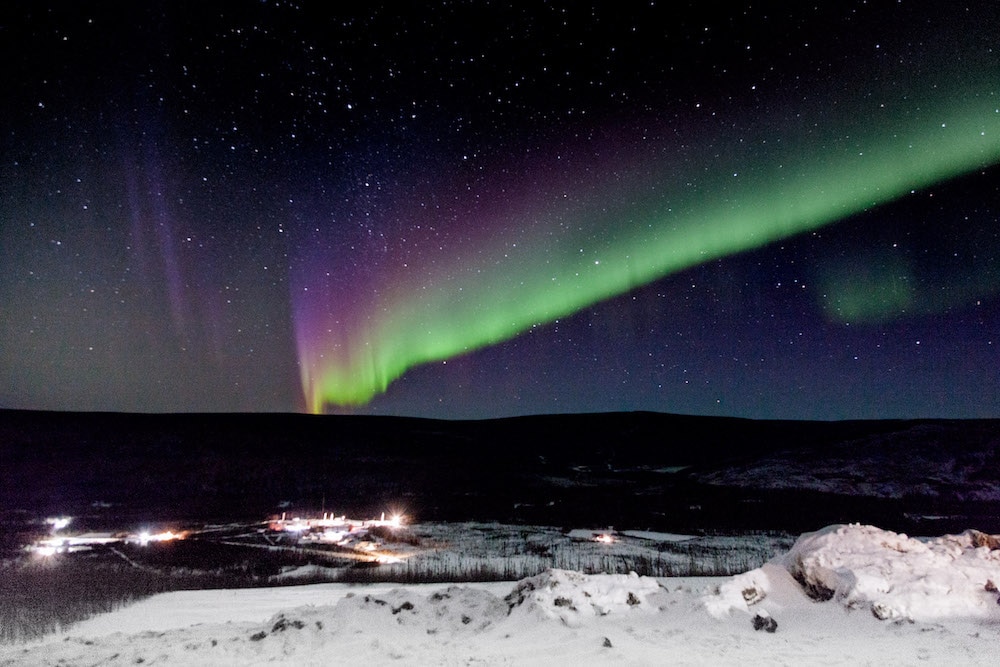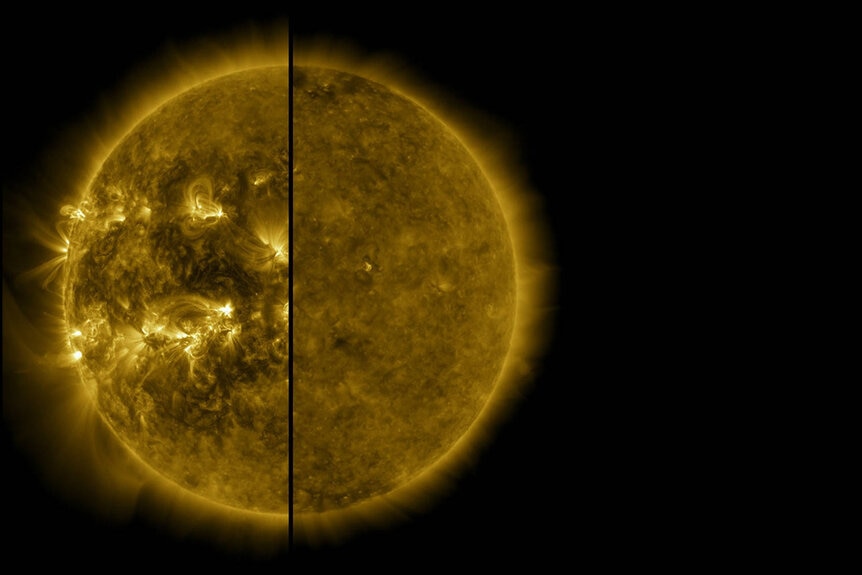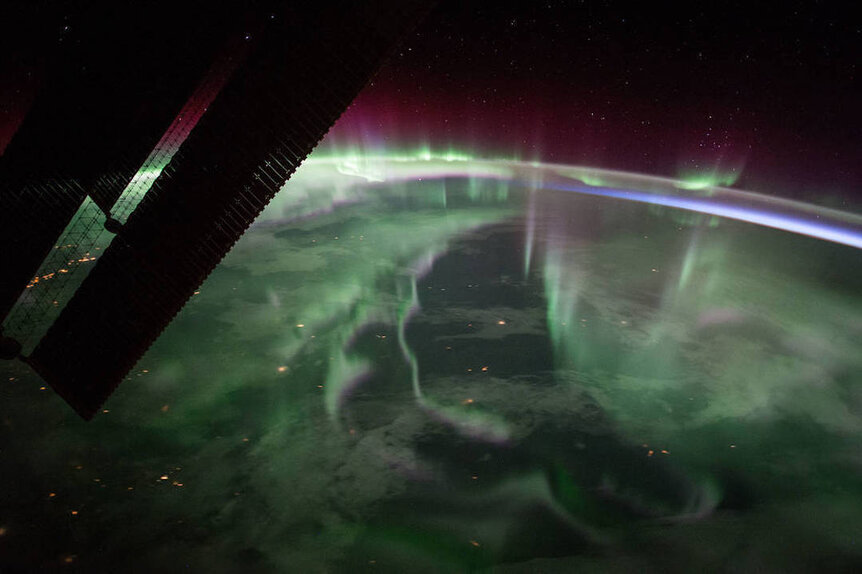Create a free profile to get unlimited access to exclusive videos, sweepstakes, and more!
Upcoming Solar Maximum Will Paint the Sky with Northern Lights
How the Sun makes the aurora and how to see them.

Ordinarily, if you want to see the Northern Lights, you have to brave the frozen landscapes of the Great White North. On any given day, the aurora are visible within a relatively small oval around the poles, and nowhere else. The frosty environs of the far north and south are hard places to live. They’re the sorts of places you plan a weeks-long fight against nature itself, like USA’s Race to Survive: Alaska, which pits eight teams of two against one another and the Alaskan landscape.
While the winning team will be rewarded with half a million dollars in prize money, the people who live their lives in Earth’s least comfortable spots are rewarded with one of the most brilliant lightshows on Earth.
SOLAR MAXIMUM AND THE SOLAR CYCLE
The Sun is a massive ball of very hot, very high pressure gas. Most of us know that, but we don’t spend a lot of time thinking about what it means. The Sun is also staggeringly, mind-bendingly big. More than 99% of all the mass in the solar system is contained within the Sun. Everything from you and me, the entire Earth, Mars, Jupiter, and everything else in the solar system is made up of the small remainder.
RELATED: Race To Survive: Alaska Survival Guide: How (Not) To Die Of Hypothermia
All of that mass, tens of thousands of planets worth, is mashed together in a sphere 865,000 miles across. That creates a lot of gravity which pulls the Sun’s material toward the center. Pressure in the core fuses hydrogen atoms together, creating intense heat and outward pressure. The combined influence of those forces — the internal pull of gravity and the outward pressure of fusion — moves electrically charged hot plasma around like a great boiling ocean of fire.
Currents of plasma twist around one another, generating intense magnetic fields which also get all mixed up. Over time, the interactions of the Sun’s magnetic field drive an increase in solar activity until it reaches what scientists call solar maximum. Then the Sun’s entire magnetic field flips and the Sun calms down for a little while before ramping up again. The Sun’s solar cycle plays out over an 11-year period, characterized by a peak and valley of solar activity.
We experience that solar activity mostly through an increase in observed sunspots. As solar activity ramps up, especially strong magnetic fields keep some of the Sun’s heat buried beneath the surface. As a result, portions of the Sun’s face are cooler (they’re still superhot, around 6,500 Fahrenheit) than the surrounding areas, and appear as black spots. But when magnetic field lines get tangled up near sunspots, they sometimes break away, sending charged plasma into space in a solar flare.
The current cycle, Solar Cycle 25, went through its solar minimum in December of 2019, when the average number of sunspots was only 1.8 over a 13-month period. When we hit solar maximum, sometime in the next couple of years, sunspots are estimated to average 115 or more, based on comparisons with previous cycles.
SOLAR CYCLE 25 COULD PEAK EARLY
Each new solar cycle gives scientists more information with which to build accurate models of the Sun’s behavior. But those cycles play out over a long time. A scientist could spend their entire career studying them and only see a handful. While we’ve been tracking the solar cycle for centuries, we’ve only got 24 of them in the books, which means that we are necessarily working with incomplete data.
The conventional way to predict the timeline and strength of a particular solar cycle has been to look at the dates and duration between solar minimums. The last four solar cycles have been weaker than the historical average, and scientists have predicted that while solar cycle 25 will be stronger than the previous cycle, it will still be weaker than average. Scientists have also predicted that solar maximum will occur in July of 2025.
A competing model, however, uses a different metric to make their predictions and has come to some alternative conclusions. Researchers from NASA and the National Center for Atmospheric Research have developed a new method for predicting solar cycle activity, which relies on the moment when the magnetic field from the prior cycle completely diminishes. That moment is known as the terminator, and can happen months or years after solar minimum, during the subsequent solar cycle. Their findings, published in the journal Frontiers in Astronomy and Space Science, suggest a relationship between the length of a cycle from terminator to terminator and the strength of the next cycle.
So far, their model has more accurately aligned with reality than other models. If that trend continues, we could see solar maximum as early as late 2024, and an average sunspot number as high as 185, placing it above the historical average.
HOW SOLAR ACTIVITY MAKES THE NORTHERN LIGHTS
Once you have an overactive star, throwing plasma-filled temper tantrums toward the atmosphere of a planet, you’ve got a recipe for aurora. When charged material from the Sun comes into contact with the Earth, most of it gets bounced away, thanks to the Earth’s own magnetic field. But the field is weakest at the poles, giving solar flares a pathway to the air.
When all of that energy and plasma hits cold gas in the atmosphere, it lights up like a solar powered space rave. Aurorae are visible at both poles and are called the aurora australis when they happen in the southern hemisphere. Moreover, both aurora appear to be mirror images of one another, occurring at the same time on opposite sides of the planet.
The most common colors you’re likely to see are faint greens and pinks, the result of solar energy interacting with oxygen about 60 miles up. Oxygen significantly higher up sometimes lights up red, while nitrogen gives off blue or purple hues.
WHAT IS THE AURORA FORECAST?
Predicting an individual solar flare and its associated aurora is a difficult endeavor and a developing science. NOAA’s Space Weather Prediction Center offers about an hour of advance notice for any impending aurorae, but they can’t really see them coming any earlier. They’re only able to give you that much warning because of space-based instruments at Earth’s L1 Lagrange Point.
The light from a solar flare travels, of course, at the speed of light, so there’s no predicting it. As soon as we see it, it’s already here. Even if we put an observation post right up next to the Sun, it could only send a message at the speed of light, which wouldn’t get here any earlier than the light itself. However, the solar winds and the charged particles move a little more slowly, at a leisurely 500 – 800 kilometers per second. Once the solar wind hits L1, we’ve got between 30 and 90 minutes before it hits us. At present, that’s the best we can do.
Predicting trends is a little easier, thanks to the Sun’s consistent solar cycle. As we approach the upcoming solar maximum, the number of sunspots, solar flares, and aurorae will increase. And their intensity is likely to increase as well. Stronger flares mean that charged particles can travel further along magnetic field lines and light up the sky at more equatorial latitudes.
During the solar storm of 1859, the Northern Lights were reported as far south as Hawaii and there is some evidence that the Southern Lights have crept even closer to the equator, in recent historical memory. If you’re hoping to catch the lights during the upcoming solar maximum, you’ll want to find a dark spot, clear skies, and keep your eyes on the space weather reports. We don’t know exactly when they are coming, but we know they definitely are.
We can’t predict the aurora, but we can predict the television schedule. New episodes of Race to Survive: Alaska air every Monday at 11/10c, on USA.




























